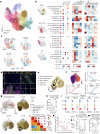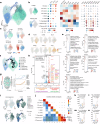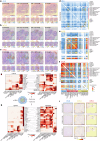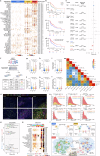Mature tertiary lymphoid structures evoke intra-tumoral T and B cell responses via progenitor exhausted CD4+ T cells in head and neck cancer
- PMID: 40335494
- PMCID: PMC12059173
- DOI: 10.1038/s41467-025-59341-w
Mature tertiary lymphoid structures evoke intra-tumoral T and B cell responses via progenitor exhausted CD4+ T cells in head and neck cancer
Abstract
Tumor tertiary lymphoid structures (TLS), especially mature TLS (mTLS), have been associated with better prognosis and improved responses to immune checkpoint blockade (ICB), but the underlying mechanisms remain incompletely understood. Here, by performing single-cell RNA, antigen receptor sequencing and spatial transcriptomics on tumor tissue from head and neck squamous cell carcinoma (HNSCC) patients with different statuses of TLS, we observe that mTLS are enriched with stem-like T cells, and B cells at various maturation stages. Notably, progenitor exhausted CD4+ T cells, with features resembling follicular helper T cells, support these responses, by activating B cells to produce plasma cells in the germinal center, and interacting with DC-LAMP+ dendritic cells to support CD8+ T cell activation. Conversely, non-mTLS tumors do not promote local anti-tumor immunity which is abundant of immunosuppressive cells or a lack of stem-like B and T cells. Furthermore, patients with mTLS manifest improved overall survival and response to ICB compared to those with non-mTLS. Overall, our study provides insights into mechanisms underlying mTLS-mediated intra-tumoral immunity events against cancer.
© 2025. The Author(s).
Conflict of interest statement
Competing interests: The authors declare no competing interests.
Figures







References
-
- Cramer, J. D. et al. The changing therapeutic landscape of head and neck cancer. Nat. Rev. Clin. Oncol.16, 669–683 (2019). - PubMed
-
- Li, A. Q. & Fang, J. H. Anti-angiogenic therapy enhances cancer immunotherapy: mechanism and clinical application. Interdiscip. Med.2, e20230025 (2024).
-
- Cabrita, R. et al. Tertiary lymphoid structures improve immunotherapy and survival in melanoma. Nature577, 561–565 (2020). - PubMed
MeSH terms
Substances
Grants and funding
LinkOut - more resources
Full Text Sources
Medical
Research Materials

